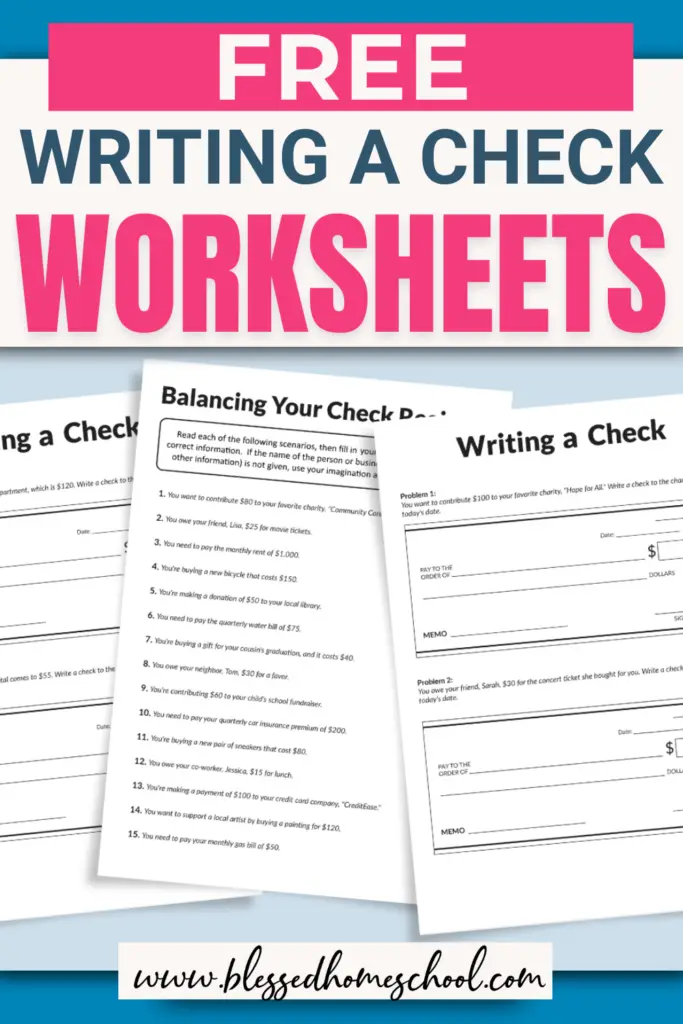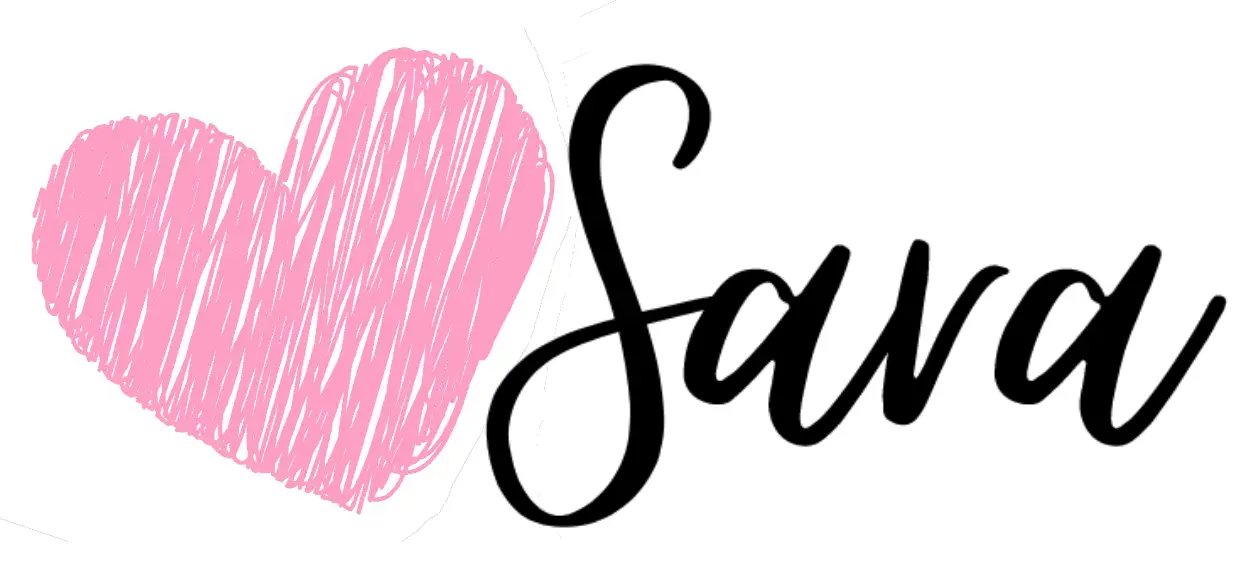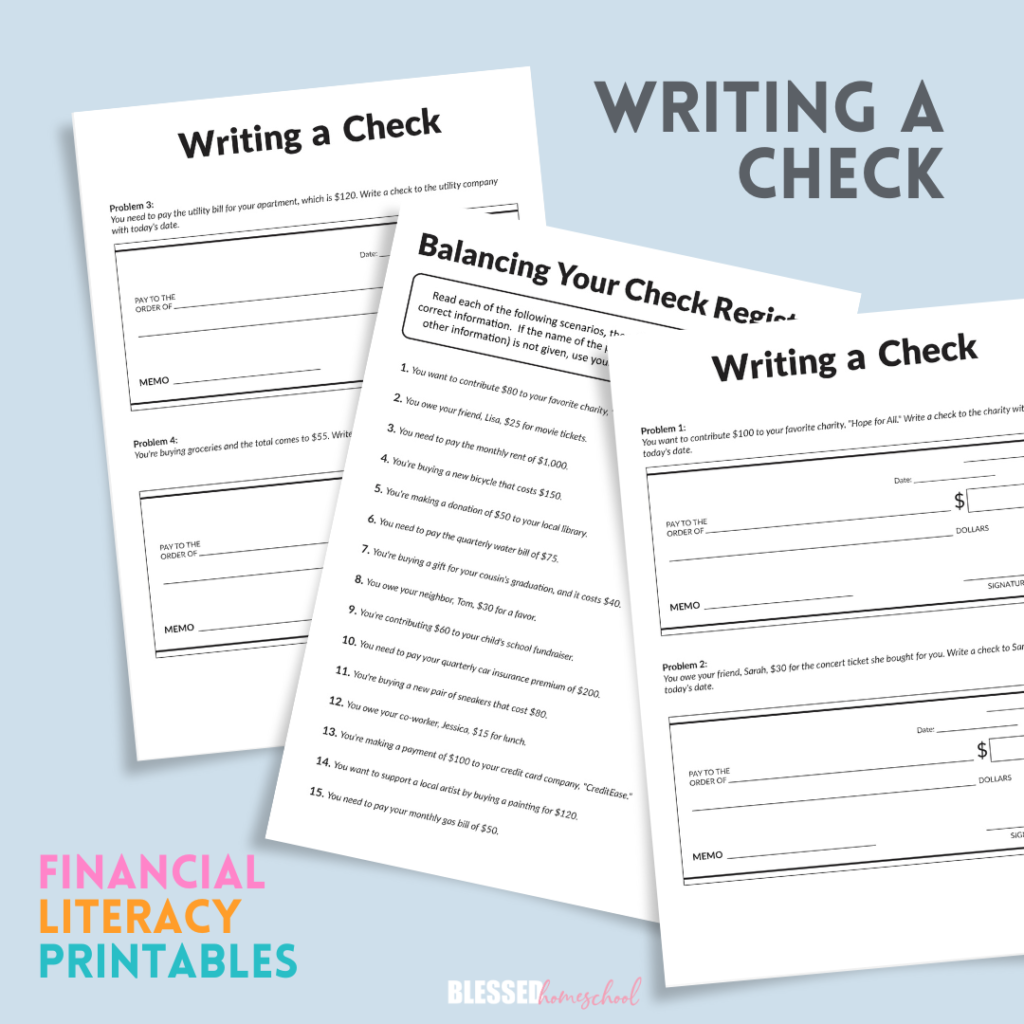How to Write a Check + FREE Writing a Check Worksheet
Just so you know, this post contains affiliate links. That means if you use them to make a purchase, I may earn a commission. You can read my full affiliate disclosure HERE.
Are you (like me) always searching for ways to teach real-world life skills in your homeschool routine?
Honestly, as much as we focus on reading, math, and science, we sometimes forget about practical skills like teaching kids about money. But it’s so important!
Even though we live in a world dominated by digital payments—debit cards, PayPal, and all that—teaching our kids how to write a check is still valuable.
And it’s more than filling out a piece of paper. I feel this skill is also about understanding responsibility, financial transactions, and how money really works.

Financial literacy, in particular, is one area many parents want to emphasize in their homeschool, and my Writing a Check Worksheet can be a great addition to your lesson plans that makes teaching check-writing easy, fun, and practical.
Writing a check teaches responsibility, proper record-keeping, and a deeper understanding of how money moves from one person to another. Let me share how you can incorporate this worksheet into your homeschool routine and why it’s a must-have for teaching financial literacy!
Why Teach Financial Literacy
As homeschool moms, we have a lot on our plates—teaching everything from math to science to history. But financial literacy? Sometimes that feels like it’s buried under all the other things we juggle. Yet, it’s one of the most important life skills we can give our kids.
By teaching them things like budgeting, saving, and yes, even writing checks, we’re setting them up for success in real-world financial responsibility.
Knowing how checks work helps kids grasp important financial concepts early on. Even though checks aren’t as common as they once were, they still exist! Think of things like paying rent, utilities, or even making donations. Understanding how a check works makes sure your kids aren’t clueless when the time comes to use one.
What Exactly is a Check, and How Does It Work?
If you hand your child a checkbook register today, there’s a good chance they’ll think it’s a relic from the past—like a VHS tape or a floppy disk! But checks are still used, and understanding how they work is an important life skill.
So, let’s break down the art of check writing in a way that makes sense for kids.
At its core, a check is like giving permission to your bank to pay someone else on your behalf. When you write a check, you’re telling the bank, “Hey, take this amount of money from my account and give it to this person or business.”
The check acts as both a record and a promise that the funds will be available when the person cashes or deposits it.
Think of it as a written instruction. You’re filling out all the details (like the name of the person to pay and how much), and once it’s signed, the bank knows what to do with the money.
It’s simple in theory, but it teaches kids a lot about responsibility—like making sure they have enough funds in their account and keeping track of what they’ve spent.

Beyond being just a piece of paper, a check introduces the concept of trust and accountability in financial transactions.
You’re trusting that the bank will follow through on your instructions, and the person receiving the check is trusting that the funds are available.
This makes writing checks an important tool for understanding larger financial systems, even in today’s digital world.
How the Writing a Check Worksheet Makes Learning Fun
Teaching financial literacy, especially something like writing a check, might sound a little dry at first. But with my check writing worksheet, I wanted to make it both practical and fun, turning it into an engaging learning experience for kids. Here’s how this worksheet does exactly that:
Breaking Down Components in Simple Terms
When you first look at a check, it might seem like a lot of blanks to fill in. But the worksheet takes all the guesswork out by breaking down each part of the check and explaining it in simple, easy-to-understand terms. It covers:
The Date: Why it’s important to write the correct date.
Payee: Who you’re paying and how to make sure you spell their name right.
Amount: Why it needs to be written in both numbers and words (and yes, there’s a trick to getting this right every time!).
Memo Line: A spot for your child to jot down what the check is for—whether it’s pretend groceries or paying a friend back.
Signature: Teaching your child that the signature is the final stamp of approval, making the check official.
By walking through each component, kids not only learn what each part is but why it matters in a financial transaction. This approach helps them see that a check isn’t just a piece of paper—it’s an important tool for managing money.
Simulating Real-Life Scenarios
To make the learning experience even more engaging, the worksheet encourages role-playing.
Kids can pretend they’re writing checks for groceries, paying bills, or even donating to a cause. These activities make the whole process more relevant to their daily lives, giving them a sense of purpose while they learn.
For example, you can set up a “grocery store” at home where they have to pay for their items by writing a check. Or, create a “bill pay” station where they pretend to settle household bills. This transforms a simple worksheet into a full-fledged interactive experience, making learning about checks feel real and practical.
Reinforcing Spelling and Number Writing Skills
Here’s where the worksheet goes beyond just financial education—it sneaks in language arts and math practice too!
Writing the amount of money in both numbers and words provides a double layer of reinforcement. Your child will get valuable practice spelling out numbers correctly (a skill that’s not as easy as it sounds!) and making sure they write the correct numerical values.
This step builds confidence in spelling and strengthens their ability to work with numbers. It’s not just about writing a check—it’s about ensuring they have the literacy and math skills needed to complete the task accurately. It’s like hitting two birds with one stone!
The Power of Repetition
Let’s face it, some skills just take time to master. That’s why the worksheet offers plenty of opportunities for repetition.
Kids can practice writing checks over and over, trying out different scenarios and amounts. Whether they’re writing a check for a small purchase or a larger “bill,” the repetitive nature of the worksheet helps them solidify the skill.
With each practice session, their comfort and confidence will grow. Soon enough, writing a check will become second nature. The best part? The more they practice, the better prepared they’ll be for real-life financial tasks down the road.
This printable is simple but effective, making it an ideal resource for homeschoolers. Here’s what’s included:
- A detailed explanation and example of how to write a check.
- Printable templates for hands-on practice.
- A check register template to teach kids how to track their transactions.
- Six problems that involve writing checks in various real-world scenarios.
- A list of 15 situations where kids practice balancing their check register.
Teaching Money Management
Check-writing isn’t just about filling out a piece of paper; it’s part of a broader financial education that introduces kids to essential concepts of money management. By teaching them how to write checks, you’re also opening the door to discussions about the responsibilities that come with handling money.
One important aspect to introduce is balancing a checkbook. While writing a check is the first step, keeping track of what’s spent is just as important. By using the check register template included in the worksheet, you can show your child how to record each transaction and keep an eye on their account balance.
This simple habit helps kids understand the importance of being mindful about their money and knowing exactly how much they have left.
Another key lesson is understanding bank fees. Writing a check involves responsibility—if there isn’t enough money in the account, the check can bounce, resulting in overdraft fees. This is an important opportunity to teach kids that managing money carefully prevents costly mistakes.
By linking the act of writing a check to these real-world consequences, they learn to be more thoughtful about their spending.
Finally, this worksheet serves as a natural stepping stone to discussing the difference between traditional and digital payments. While checks are less common today, they still play a role in financial transactions.
At the same time, digital payment methods—like a debit card, online banking, and mobile apps—are becoming more dominant. Use this moment to talk about how banking has evolved, comparing checks with newer payment methods, so your child has a comprehensive understanding of how money moves in our modern world.
Wrapping Up
Teaching financial literacy might sound intimidating at first, especially if you didn’t have a lot of experience with it growing up. But with simple tools like the Writing a Check Worksheet, you can easily introduce these important life skills without feeling like you need to be a financial expert.
The worksheet is designed to make the process approachable, breaking it down into clear, manageable steps that you and your child can work through together.
It’s important to remember that practical life skills are just as critical as traditional academics. By teaching your child how to write checks and manage their money, you’re equipping them with skills they will use throughout their lives. This goes beyond the classroom and empowers them to make smart financial decisions in the future.
You’re already doing so much by homeschooling and focusing on academics, but adding in lessons like these helps round out your child’s education.
Don’t worry about making it perfect—what matters most is that your child starts to understand the basics of money management in a way that’s fun and accessible. You’ve got this, and with tools like this worksheet, you’re helping your kids build a foundation for financial success.

Related Posts
- Teaching Kids About Money? 9 Things You’ll Want to Cover
- 4 Simple and Effective Budgeting Activities for Kids
- Best Books and Games to Help Teach Kids About Money
Blessed Homeschool is a participant in the Amazon Services LLC Associates Program, an affiliate advertising program designed to provide a means for sites to earn advertising fees by advertising and linking to Amazon.com. You can read my full affiliate disclosure HERE.



